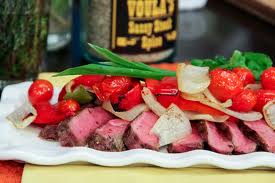You can always serve a charming roast or a slow-cooked meat stew for dinner, but nothing beats the basic steak from a relatively expensive meat cut as the main course of a lavish meal. For most people, a good steak is considered tricky to make at home, thus it is a rare treat often enjoyed only in the confines of a restaurant where the dish becomes pricier than its homemade counterpart.
Do you think you can come up with a delicious steak without the aid of an £18,000 Josper grill? What about cooking a decent steak right inside your home kitchen with no char-grilling involved? Read on and find out how to cook a perfect steak from a rib-eye, a cut that seems to be widely used in steak recipes around the world.

Preparation
Food guru Harold McGee tells of the secrets to a perfect steak: warm meat and repetitive flips. The best way to warm the rib-eye before you cook it is to cover it with cling film wrap then immerse it in warm water for thirty to sixty minutes. The same steak preparation tip is recommended by numerous fine steakhouses. Chefs say that the meat must be at room temperature before you cook it.
Drying
Always pat the steak’s surface dry before you cook it. A moist steak may have difficulty forming a nice crust and may not brown properly. The moisture can also impart an unpalatable flavour associated with boiled meat.
Seasoning
Season the rib-eye generously with coarse sea salt and freshly ground black pepper. Let it stand for a few minutes. The salt and other spices you want to add must be evenly distributed on the surface of the meat. A sumptuously salty and crispy crust is one of the characteristics of a perfect steak.
Fat
If you cook the steak fast, you can manage with little or no fat added to the steak. If you want the extra flavour that comes with fat and to prevent the steak from sticking to the pan, then grease the pan with butter and garlic or brush the meat with oil. For an extra boost of flavour, you can also drizzle the rib-eye with olive oil and lemon juice while letting the meat rest.
Temperature
If you like your rib-eye steak to retain a charred flavour, then pre-heat the pan to a high temperature, place the steak on the pan, then quickly turn down the heat.
For thick steaks, try moderate heat. You get a nicely charred crust and a juicy interior. Moderate heat cooking levels also prevent overcooking and allow for decent caramelisation. However, with moderate temperatures, the steak’s crust may not be scorched. If you like darkened crust, then start with very high heat.
Frequent Flipping
Frequently turning over the rib-eye steak keeps its insides moist. The frequent flipping prevents either side of the steak to absorb or discharge significant amounts of heat. The crust also ends up becoming less overdone. Another great suggestion to achieve the perfect rib-eye steak is to press it down while it cooks. This enhances thermal contact and improves flavour.
Peter Richardson loves to hold backyard cookouts for his friends and family. An avid blogger, he posts mainly on food and cooking sites.

